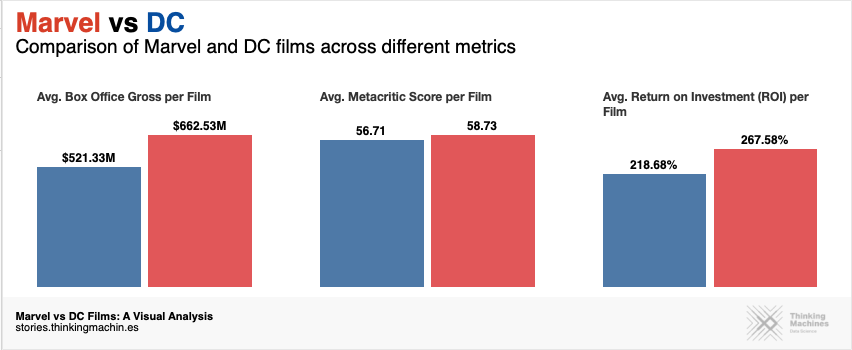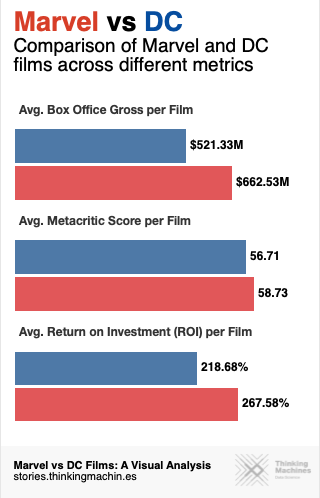
Marvel vs DC Films: A Visual Analysis
This data story was originally published in December 2018 and updated in April 2021 to reflect the latest data available.
With a new Marvel or DC film hitting cinemas nearly every few months, comic book nerds are no longer the only ones with opinions on the age-old rivalry between Marvel and DC. But what does the cold, hard data have to reveal about this debate?
Box office battle
There are a lot of ways we could compare the film success between the two comic book publishers, but let’s start with the most obvious: box office gross. It’s helpful to look not just at how much money the films made, but at how much money they cost too.

Note: All amounts were adjusted for inflation.
Higher budget films usually earn more at the box office, with some notable exceptions and standouts:
Earth’s Mightiest Films
The two latest Avengers films, Avengers: Endgame (Marvel, 2019) and Avengers: Infinity War (Marvel, 2018), were the clear standouts, achieving the highest box office gross overall, while also being given the highest budget. In fact, among all Marvel and DC films, the top four highest grossing movies were the four Avengers films.
The World’s Greatest Box Office Bomb
In contrast, while Justice League (DC, 2017) cost almost the same as Avengers: Infinity War to produce, it earned barely a third of the box office gross.
The Merc with the Money
Even the low budget miracle that is Deadpool (Marvel, 2016) managed to earn 22% more than Justice League, with less than 20% of the DC film’s budget. That’s a huge improvement over Ryan Reynold’s DC foray, Green Lantern (DC, 2011), which (before 2020) was the lowest grossing film among those with an above-average budget.
Even Heroes Fall
Due to the COVID-19 pandemic, movie theaters experienced closures and restrictions globally. This led to the below average box office gross for all Marvel and DC films in 2020.
Overall, Marvel movies grossed on average 34% higher than DC films, while only spending 7% more creating them.
Does popularity = quality?
Marvel films definitely earn more than DC films. But are popular movies necessarily better? Let’s plot the correlation between the films’ box office gross and Metacritic scores.

Note: All amounts were adjusted for inflation.
Loved by Critics and Crowds
Out of all the films, Black Panther (Marvel, 2018) achieved the highest Metacritic score. We can see it in the upper right quadrant among other movies that had above average ticket sales and critic ratings. Forty-three percent of Marvel films can be found in this quadrant, but in contrast only twenty percent of DC films made the cut: The Dark Knight (DC, 2008), The Dark Knight Rises (DC, 2012), Wonder Woman (DC, 2017), Batman (DC, 1989), Superman (DC, 1978), and Joker (DC, 2019).
Critically-Loved Box-Office Duds
In the bottom right quadrant, we see the movies that got high scores from critics but low box office turnout. A number of DC films fell into this quadrant, such as The Lego Batman Movie (DC, 2018), Teen Titans Go! To the Movies (DC, 2018), Shazam (DC, 2019) and Superman II (DC, 1980), which had the second highest Metacritic score among all films listed.
Disliked by All
The bottom left quadrant is home to movies that both critics and consumers would agree were pretty bad. The two publishers both had a significant number of movies in this quadrant - thirty-three percent for DC and thirty-five percent for Marvel. Among the movies in this quadrant were: Superman IV: The Quest for Peace (DC, 1987), Batman & Robin (DC, 1997), Fantastic Four (Marvel, 2015), Catwoman (DC, 2004) and Howard the Duck (Marvel, 1986).
Crowd-Pleasing Critical Stinkers
The last quadrant on the upper left is for the movies that did well in the box office but were critically unremarkable. There aren’t many movies in this quadrant, but the more notable ones include: Venom (Marvel, 2018), Aquaman (DC, 2018), Batman v Superman: Dawn of Justice (DC, 2016), Suicide Squad (DC, 2016), and Justice League (DC, 2017).
According to critics, Marvel is better than DC, but only by a hair’s breadth, with an average Metacritic score of 58.73 and over DC’s 56.71.
Worth the investment?
Marvel seems to be beating DC both at the box office and with critics. But Marvel also spends a bit more than DC on its films. Would our graphs tell a different story if, instead of looking at raw earnings, we looked at return on investment as correlates with critical reception?

The majority of the movies didn’t stray too far from the average in terms of their return on investment or ROI; however, this made certain outlier movies stand out even more.
Best and Worst Bang-for-Buck
The most obvious outlier is Joker (DC, 2019), which had the highest ROI among all movies listed (over six times the average!), while also achieving a slightly above-average Metacritic score. Deadpool (Marvel, 2016) and Batman (DC, 1989) also had significantly high ROIs, while also achieving even higher Metacritic scores.
Another outlier, with a relatively high ROI, but a pretty low Metacritic score, is Venom (Marvel, 2018); it managed to achieve a slightly higher ROI than Avengers Endgame (Marvel, 2019) and Black Panther (Marvel, 2018), while receiving an even lower Metacritic score than the box-office flop Green Lantern (DC, 2011).
Unfortunately, superhero films aren’t always a good investment, as there are a handful of (mostly DC) films that actually cost more money than they earned: Supergirl (DC, 1984), Superman IV (DC, 1987), Catwoman (DC, 2004), Punisher: War Zone (Marvel, 2008), Jonah Hex (DC, 2010), The New Mutants (Marvel, 2020) and Wonder Woman 1984 (DC, 2020).
The Unexceptional Spider-Man
A film that’s more difficult to notice in the chart is Spider-Man 3 (Marvel, 2007), which, despite all the buzz, both negative and positive, was pretty unremarkable — neither good nor bad relative to the other movies we plotted, in terms of both metrics.
The Fall of Superman
An interesting series of movies is the Superman films from 1978-1987. Both Superman (DC, 1978) and Superman II (DC, 1980) were well received by critics, achieving very similar Metacritic scores; despite that, Superman II was unable to match its predecessor’s financial success. The movies that followed got progressively worse in terms of both metrics; Superman III (DC, 1983) failed to impress the critics, and Superman IV (DC, 1987) was so disappointing it actually lost money in the box office.
On average, Marvel films had 22% higher ROI than DC films.
The Final Verdict



Overall, Marvel trumps DC in all the metrics we explored: box office gross, Metacritic scores, and return on investment.
While it does appear that Marvel reigns supreme in the realm of superhero films, we’ve only just scratched the surface of this debate. This is a rivalry that has spanned decades and mediums. What insights would we uncover if we compared these metrics over time? Would the results be different if we looked at TV or comics instead of films?
Is the battle over...or has it only just begun?
Notes on the Data
Data Sources
Data Scope
- Data was limited to what was included in our data sources
- Data was scraped on November 15, 2018 and re-scraped on April 19, 2021
- Films analyzed only included those from comics that were published under either Marvel or DC (so comics published under imprints of Marvel and DC were not included)
- Films analyzed only included those with recorded box office gross, budget and Metacritic scores in the data sources
- For simplicity, the only critic ratings included were Metacritic scores

